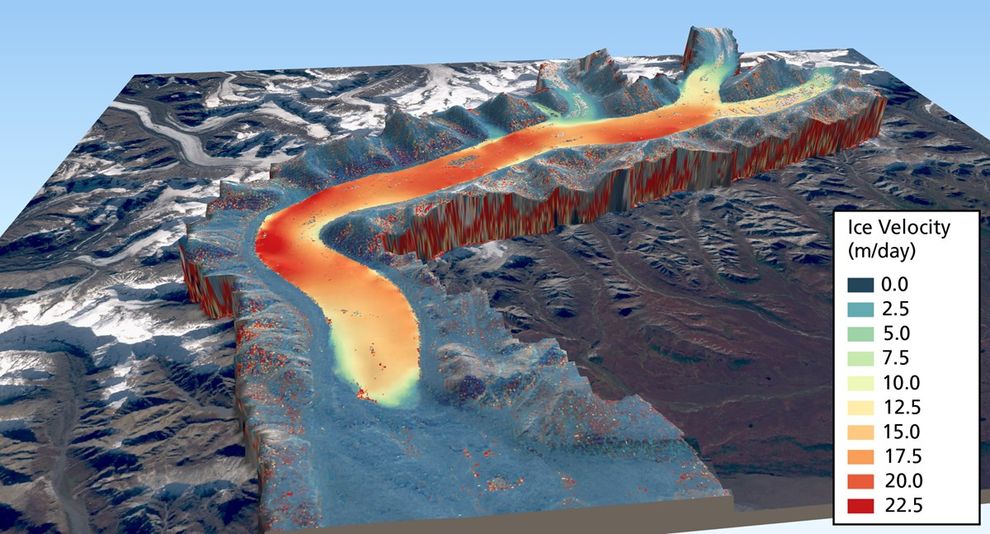Alaska’s mighty Muldrow Glacier is moving 50 to 100 times faster than normal.
It’s a major surge. Large parts of the 39-mile-long “river of ice” are progressing some 30 to 60 feet per day, as opposed to just a few inches.
On a warming globe where many glaciers are receding, some glaciers still have fast bursts of movement foward, though such surging glaciers are rare. Only one percent of glaciers surge. The Muldrow surge, occurring on the north side of Alaska’s towering Denali — North America’s tallest mountain at 20,310 feet — is the glacier’s first rapid activity in 64 years.
These surges are spectacular, dramatic natural events. Colossal masses of ice crack and groan as they flow like a river in slow motion.
“If you sit beside a fast-moving glacier you hear the crashing and tumbling of the ice. People have likened the sound to the rumbling boxcars of a train,” said Gwenn Flowers, a glaciologist and professor at Simon Fraser University in Canada. Flowers researches surging glaciers in the Alaska-Yukon region.
ROAR SPLOOSH…what are your onomatopoeic words for what a surging glacier sounds like?
The pop of the ice from the #MuldrowSurge can likely be heard for miles.
A sound monitoring station has been set up to capture it.
We can’t wait to hear those recordings! POW!NPS Photo pic.twitter.com/wWA0TAS609
— Denali National Park (@DenaliNPS) April 14, 2021

A graphic showing how quickly ice is moving on the Muldrow Glacier.
Image: Mark Fahnestock / nps
The surge
In the modern day, with aerial, satellite, and seismic observations, scientists have gained detailed insight into the new Muldrow surge.
“The amount of information we have about this surge is incredible,” remarked Joe Shea, a glacier scientist and assistant professor of environmental geomatics at the University of Northern British Columbia. He noted seismic readings (measuring vibrations in the earth) which showed the glacier’s first rumblings of heightened activity in late 2020.
The National Park Service said a pilot spotted unusual activity on the glacier in early March. Major cracks, called crevasses, appeared on the typically smooth glacier — telltale signs of robust movement. The activity has continued.
What stoked this big surge? A major factor is what’s happening under the glacier.
“Fast glacier flow is caused by water trapped under the ice which makes the glacier bed slippery,” explained Flowers. Water gets trapped because a rare surge-type glacier, unlike normal glaciers, has decades-long periods of quiet, when it moves extremely slow (this speed is different for each glacier but is around 10 to 100 times slower than a glacier’s respective surge). During this time, the glacier doesn’t regularly let water easily flow out and escape, so it builds up. Eventually, the accumulated water below can trigger the glacier to move rapidly by reducing friction with the bedrock and making things slippery.

An aerial view of the Muldrow Glacier from March 13.
Image: nps
Surging glaciers repeat this process of long quiet and sudden bursts. “Surge-type glaciers behave a bit like yo-yos,” said Flowers. “They tend to surge repeatedly and at somewhat regular intervals.”
The big, looming research question is what might cause surge glaciers to have long periods of quiet, when the glacier can stick to the rock below. Perhaps the Muldrow surge will provide some answers.
Surges in a warming climate
Many of us are familiar with the global trend of receding and thinning glaciers as the planet relentlessly warms. It’s happening in Europe, Iceland, the Himalayas, Antarctica, the U.S., and beyond.
So just reading a headline about “a surge” might sound unexpected or counterintuitive. But these surges aren’t counterintuitive. They don’t mean a glacier is growing.
“The total mass isn’t changing [during a surge],” explained Shea, noting Muldrow is likely somewhat smaller than it was 50 years ago (because most glaciers are). Rather, the glacier is just rapidly rearranging itself, said Shea, as ice suddenly surges forward.
But while climate change, which often thins glaciers, doesn’t trigger a specific surge, it can certainly influence where or how often they occur, explained Flowers. “For example, surges of some large glaciers are becoming less extensive in our warming climate, while surges of some small glaciers have stopped altogether,” she said, noting that the time between surges is also changing in some places.
Eventually, a warming climate might mean fewer overall surges. That’s because melting glaciers will have less ice, so there won’t be as much ice available to accumulate and dramatically move foward.
See Also: Why the sun isn’t causing today’s climate change
“At some point…a warming climate will undermine the ability of surge-type glaciers to build an ice reservoir, so we should expect fewer surges in the long term,” said Flowers.
